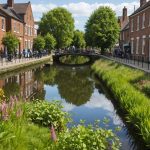Overview of Canal Restoration Initiatives in the UK
The restoration of canals in the UK is a movement rich in historical context, marked by numerous key initiatives and organisations. Originally constructed in the 18th and 19th centuries, these waterways were pivotal for industrial transport. However, with the advent of railways, they fell into disrepair. Today, their value lies beyond the historical; ecological benefits and biodiversity are primary drivers behind restoration efforts.
One significant organisation championing canal restoration is the Canal & River Trust, which manages over 2,000 miles of waterways. Their work is complemented by local groups such as the Inland Waterways Association, focusing on both the structural repair of canals and enhancing their ecological roles. Initiatives have aimed at revitalising these waterways to support both aquatic and terrestrial life forms.
This might interest you : Boosting uk farming: eco-friendly strategies to safeguard barn owl populations
Central to many canal restoration projects are biodiversity-focused goals. These initiatives aim to reintroduce native species, improve water quality, and create habitats conducive to a wide range of wildlife. Restored canals become thriving ecosystems, benefiting regional biodiversity. By focusing on increasing habitat complexity, these efforts also address larger ecological concerns, contributing to the resilience of local natural environments. In essence, canal restoration intertwines cultural heritage preservation with sustainable ecological enhancements.
Ecological Benefits of Canal Restoration
Restoring canals plays a pivotal role in enhancing urban ecosystems. These water bodies have the potential to rejuvenate local environments, which brings about significant advantages to both urban areas and the wildlife habitats that thrive within them.
Additional reading : Crafting urban green spaces in the uk: a strategic guide to enhancing amphibian ecosystems
Impact on Local Wildlife
One of the most significant benefits of canal restoration is the positive impact on local wildlife. Species recovery and the creation of new habitats become possible as restored canals serve as oases for diverse species. Additionally, canals act as wildlife corridors, facilitating movement and breeding opportunities for animals, thereby boosting biodiversity. Numerous ecological studies have observed that properly maintained canals contribute to the resurgence of various species, confirming the restoration’s ecological effectiveness.
Water Quality Improvement
Restoration efforts have a profound impact on water quality improvement. By cleaning and revitalising these waterways, the health of entire ecosystems enhances, fostering a more biodiverse environment. Improved water quality often results in a healthier ecosystem, as seen in various case studies, which highlight significant enhancements post-restoration efforts. Such improvements in water quality are strongly linked to increased biodiversity and ecosystem vitality.
Enhancement of Urban Green Spaces
Integrating restored canals into urban green spaces is a innovative trend in urban planning. These efforts lead to an increased green cover, offering tangible benefits for biodiversity and human residents alike. Restoring canals not only contributes to ecological richness but also transforms urban landscapes into sustainable and biodiverse environments.
Case Studies of Successful Restoration Projects
Exploring case studies offers valuable insights into the effectivity of urban landscape restoration on biodiversity improvement.
Specific Examples of Restoration Efforts
In the UK, notable projects like the Glasgow Canals and River Irwell Restoration have shown the transformative power of urban revitalisation. These projects have not only rejuvenated deteriorated landscapes but also facilitated community engagement by prioritising both ecological and social impacts. Before-and-after analyses reveal enhanced biodiversity, with native species resurfacing in previously depleted areas. Community-led initiatives, such as the Forth & Clyde Canal restoration, illustrate how active local involvement can sustain long-term verdant environments.
Quantitative Data on Biodiversity Outcomes
Efforts to measure biodiversity improvements incorporate a variety of metrics, including species richness and habitat conditions. Statistics often highlight an increase in specific flora and fauna populations, demonstrating the positive impacts of ecological interventions. Reporting relies on robust methodologies, including site surveys and remote sensing. Detailed analyses from projects like the Lea River Park highlight significant biodiversity gains, quantifying benefits through detailed data comparisons before and after intervention.
Collaboration with Local Communities
Engagement strategies emphasise collaboration with stakeholders to align restoration goals with community expectations. Volunteers significantly contribute to the groundwork of projects such as the Wandle River Restoration. This joint approach enriches biodiversity, offering communities both educational and recreational opportunities thus fostering a sense of environmental stewardship.
Challenges and Future Directions
Addressing the challenges of canal restoration involves navigating a complex web of environmental and social factors. One major obstacle is deteriorating infrastructure, which requires substantial investment and innovative techniques to revitalize effectively. Additionally, urban biodiversity faces threats from pollution and human activities, making its preservation a priority in restoration efforts.
Another pressing challenge is the implications of climate change. Rising temperatures and increased rainfall can exacerbate flooding, affecting the structural integrity of canals. This necessitates a shift towards sustainable practices that are resilient to climatic variations. Preserving biodiversity within urban waterways involves initiatives that mitigate these impacts and foster healthy ecosystems.
Future initiatives must encompass more than just immediate restoration. Long-term sustainability requires comprehensive plans that integrate ecological, social, and economic perspectives. One promising approach is the adoption of green infrastructure, such as using permeable surfaces and vegetation buffers to manage stormwater and support wildlife habitats.
Additionally, community engagement is crucial. Encouraging local stakeholders to participate actively in restoration projects not only fosters a sense of ownership but also ensures that solutions are tailored to the specific needs of the community. As we look ahead, these future directions will be paramount in overcoming the current challenges and achieving sustainable canal restoration.











